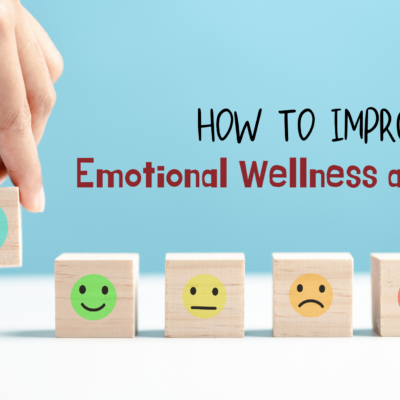How to Improve Emotional Wellness at Work: In the fast-changing and usually demanding world of work, it is easy for emotional wellness to take a backseat. Yet, promoting emotional wellness in the workplace is not just useful for employees; it also contributes to a more effective and pleasant work environment overall. From easing stress to improving job satisfaction, prioritizing emotional wellness can lead to a myriad of positive effects.
Also Read:
- How to Reframe Negative Thoughts?
- Benefits of Walking in Nature on Mental Health.
- So Bored with Life? Here’s What You Need to Know.
- Signs You Have Working From Home Depression.
- How To Be Positive Everyday?
In this article, we will talk about different strategies to improve emotional wellness at work, creating for both employees and employers a healthier and more supportive work culture.
How to Improve Emotional Wellness at Work?
Encourage Open Communication
Effective communication lies at the heart of emotional wellness in the workplace. Promote an environment where employees feel comfortable expressing their thoughts, concerns, and emotions without fear of judgment.
Regularly check between managers and team members to discuss workload, challenges, and any other issues impacting emotional well-being. Additionally, encourage open conversation during team meetings and promote active listening to ensure everyone feels heard and valued.
Provide Resources for Stress Management
Work-related stress is a common barrier to emotional wellness. Provide employees with resources and tools to handle stress effectively. Give training sessions on stress management techniques such as mindfulness, deep breathing exercises, or time management strategies. Consider providing access to mental health resources such as counseling services or employee assistance programs to support those facing influential stressors.
Promote Work-Life Balance
Keeping a healthy work-life balance is important for emotional well-being. Motivate employees to set boundaries between work and personal life by encouraging flexible work arrangements, such as remote work options or flexible hours.
Enable the use of vacation days and avoid overtime work unless it is necessary. As a manager, you should respect these boundaries and avoid sending emails or assigning tasks outside of regular working hours.
Promote a Culture of Appreciation
Praise and appreciation are powerful motivators that contribute to emotional wellness. Celebrate achievements, milestones, and contributions regularly, whether through public acknowledgment, rewards, or team events. Promote peer-to-peer recognition to promote a culture of appreciation and support among colleagues. Recognizing and valuing each person’s unique contributions can increase morale and support team cohesion.
Encourage Professional Development
Investing in employees’ professional growth and development not only improves job satisfaction but also contributes to their emotional well-being. Provide opportunities for skill development, training programs, and career advancement ambitions.
Encourage employees to follow their interests and passions within the organization, whether through cross-functional projects, mentorship programs, or tuition reimbursement for further education. Feeling challenged and engaged in their work can greatly affect emotional wellness.
Create a Supportive Environment
Creating a supportive workplace culture is important for promoting emotional wellness. Encourage teamwork, collaboration, and mutual respect among employees.
Offer support networks such as employee resource groups or mentorship programs to promote connections and deliver a sense of belonging. Ensure that managers are approachable and available for support and guidance, and empower them with the skills to identify and handle emotional pain among their team members effectively.
Prioritize Workload Management
Overwhelming workloads can take a toll on emotional well-being, leading to stress, burnout, and reduced productivity. Promote realistic goal-setting and prioritize tasks to stop employees from feeling overwhelmed.
Provide enough resources, support, and assistance to help employees handle their workload effectively. Encourage delegation and teamwork to distribute tasks evenly and prevent people from becoming overburdened.
Promote Physical Wellness
Physical health and emotional wellness are closely interconnected. Encourage healthy habits such as regular exercise, nutritious eating, and enough sleep among employees. Provide access to wellness programs, gym facilities, or health-related workshops to encourage physical well-being.
Enable employees to take regular breaks throughout the workday to recharge and refocus, relieving stress and improving overall emotional wellness.
Lead by Example
Leadership plays an important role in shaping organizational culture and promoting emotional wellness. Lead by example by prioritizing your emotional well-being and demonstrating healthy habits and behaviors.
Be transparent, authentic, and empathetic in your interactions with employees, promoting trust and openness within the organization. Show genuine concern for the well-being of your team members and actively support their emotional wellness initiatives.
Seek Feedback and Adapt
Finally, constantly seek feedback from employees regarding their emotional wellness experiences in the workplace. Conduct surveys, focus groups, or one-on-one discussions to collect insights into their requirements, challenges, and suggestions for improvement.
Use this feedback to adjust and refine emotional wellness initiatives, policies, and practices to better meet the requirements of your workforce. By listening to and valuing employee input, you indicate a commitment to their emotional well-being and contribute to a culture of continuous improvement.
At The End
Prioritizing emotional wellness in the workplace is not just a moral imperative; it’s also a strategic investment in the overall health and success of your organization. By executing the above-mentioned strategies you can develop a workplace where emotional wellness flourishes, leading to happier, healthier, and more engaged employees. Remember, small changes can make a substantial difference, so start executing these strategies today to create a more emotionally supportive and fulfilling work environment for everyone.








